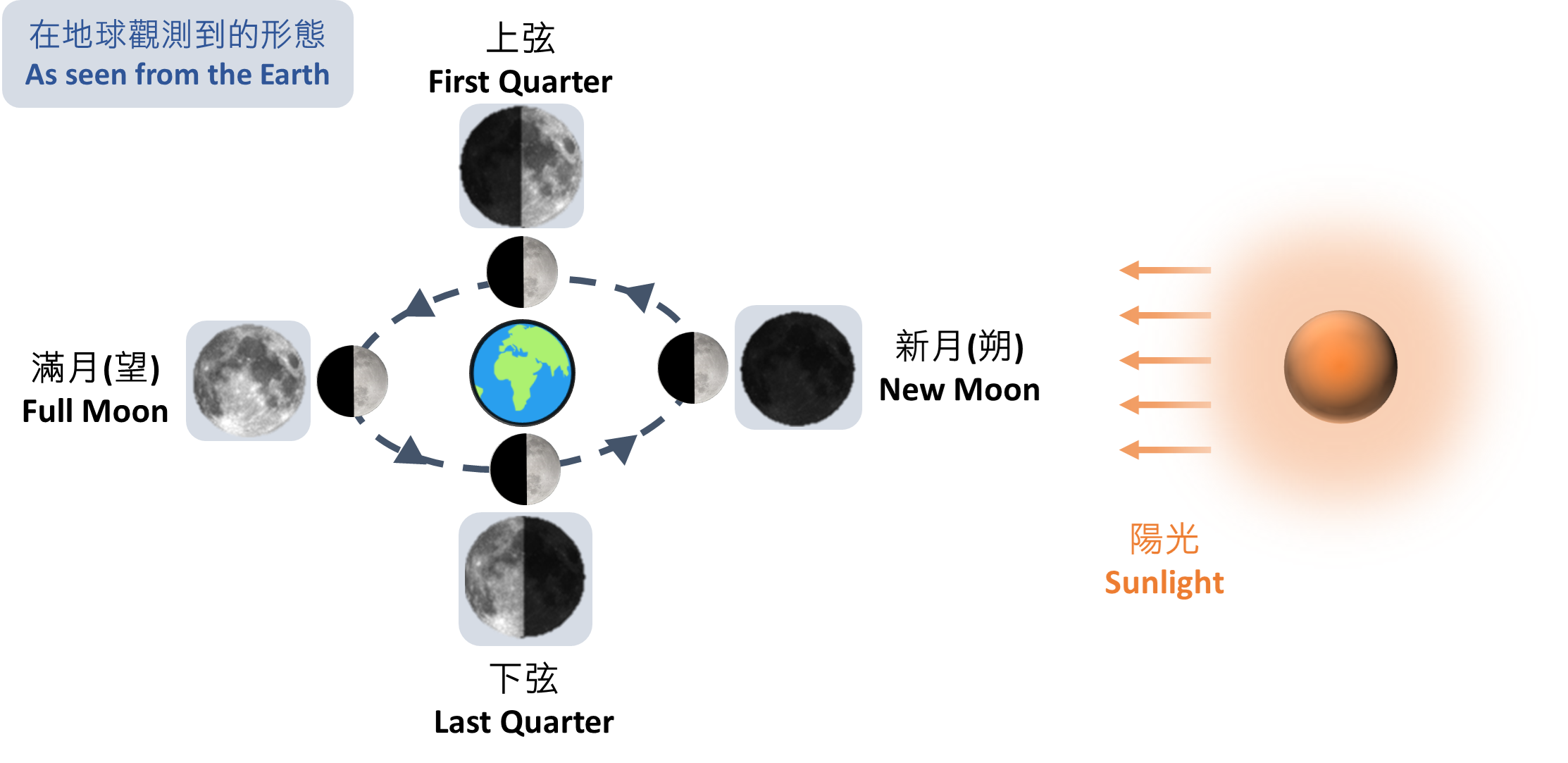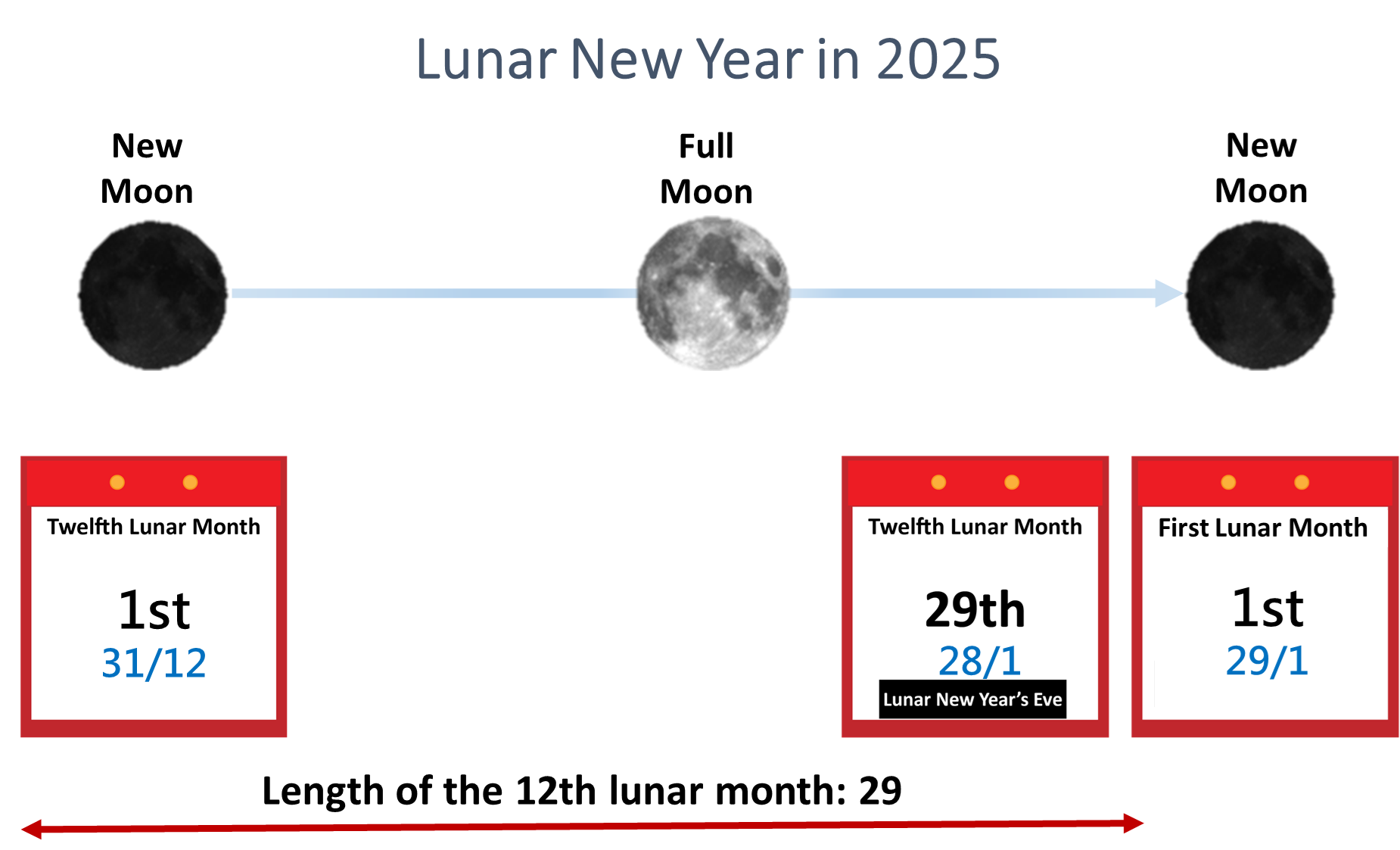No Lunar New Year’s Eve on the 30th Day for Five Consecutive Years
24 December 2024
Wong Cheuk-yiu, Wong Wai-kwong, Hui Tai-wai
As the Year of the Snake is approaching, we wish you all a happy New Year with good health. Do you realise that the Lunar New Year’s Eve will fall on the 29th day of the 12th lunar month but not on the usual 30th day in 2025? In fact, this phenomenon is not rare. The 30th day of the 12th lunar month “disappeared” 37 times in the past 100 years (1925 – 2024) according to official Chinese Agricultural Calendar. Moreover, there will be no 30th day of the 12th lunar month in the next five consecutive years (2025 – 2029). Before explaining this phenomenon, we would like to first introduce the glossary and some rules related to the Chinese Agricultural Calendar and astronomy.
In astronomy, a new moon marks the moment when the Moon and the Sun are on the same ecliptic longitude. The time between two successive occurrences of new moon is called a synodic month, which has an average length of 29.5306 days (i.e. 29 days 12 hours 44 minutes 3 seconds). In Agricultural Calendar, lunar months are fixed based on moon phases and the date on which the new moon happens is set as the first day of a lunar month. As the length of a month in the Agricultural Calendar must be an integral number, the Agricultural Calendar makes use of a combination of “short month” of 29 days and “long month” of 30 days, which approximates the average length of a synodic month.

(The diagram is for illustration purpose only. The Sun, the Earth and the Moon are not drawn to scale.)
How the last day of a lunar month is numbered depends on whether the month is short or long. The last day of short months is on the 29th, while for long months, it is on the 30th. Lunar New Year’s Eve is defined as the last evening within a year in the Agricultural Calendar. The occurrence of long and short lunar months does not follow a simple and uniform pattern. Its arrangement is based entirely on two principles, namely the new moon must fall on the first day of the lunar month, and the length of a calendar month must be an integer. As illustrated by Table 1 below, in the coming decade, there will be five consecutive lunar short months in the 12th month of the Agricultural Calendar. Consequently, the Lunar New Year’s Eve in these years will not fall on the 30th day of the 12th lunar month. In fact, the probability of the 12th lunar month being a short month is around 40%. Thus, the probability of the Lunar New Year’s Eve not falling on the 30th day of the month for five consecutive years is estimated to be only about 1%. According to the Gregorian-Lunar Calendar Conversion Table [1], there will also be two similar events before the end of this century. Both events (2058 – 2063 and 2089 – 2094) may even have six consecutive years with Lunar New Year’s Eve not falling on the 30th day of the 12th lunar month.
| Gregorian Year | Time of the New Moon in the 12th Lunar Month | The First Day of the 12th Lunar Month | Time of the New Moon in the 1st Lunar Month of the Lunar New Year | The First Day of the 1st Lunar Month of the Lunar New Year | Length of the Synodic Month | Length of the 12th Lunar Month (Days) | Month Type (Long or Short) |
|---|---|---|---|---|---|---|---|
| 2025 | 31 December 2024 06:27 |
31 December 2024 | 29 January 2025 20:36 |
29 January 2025 | 29 days 14 hours 9 minutes |
29 | Short |
| 2026 | 19 January 2026 03:52 |
19 January 2026 | 17 February 2026 20:01 |
17 February 2026 | 29 days 16 hours 9 minutes |
29 | Short |
| 2027 | 8 January 2027 04:24 |
8 January 2027 | 6 February 2027 23:56 |
6 February 2027 | 29 days 19 hours 32 minutes |
29 | Short |
| 2028 | 28 December 2027 04:12 |
28 December 2027 | 26 January 2028 23:13 |
26 January 2028 | 29 days 19 hours 1 minute |
29 | Short |
| 2029 | 15 January 2029 01:25 |
15 January 2029 | 13 February 2029 18:32 |
13 February 2029 | 29 days 17 hours 7 minutes |
29 | Short |
| 2030 | 4 January 2030 10:50 |
4 January 2030 | 3 February 2030 00:08 |
3 February 2030 | 29 days 13 hours 18 minutes |
30 | Long |
| 2031 | 25 December 2030 01:32 |
25 December 2030 | 23 January 2031 12:31 |
23 January 2031 | 29 days 10 hours 59 minutes |
29 | Short |
| 2032 | 13 January 2032 04:07 |
13 January 2032 | 11 February 2032 14:24 |
11 February 2032 | 29 days 10 hours 17 minutes |
29 | Short |
| 2033 | 1 January 2033 18:17 |
1 January 2033 | 31 January 2033 06:00 |
31 January 2033 | 29 days 11 hours 43 minutes |
30 | Long |
| 2034 | 20 January 2034 18:02 |
20 January 2034 | 19 February 2034 07:10 |
19 February 2034 | 29 days 13 hours 8 minutes |
30 | Long |
Table 1 Astronomical data for the 12th lunar month and the first lunar month of the Lunar New Year from 2025 to 2034 (Short months are highlighted in yellow.)
Under what conditions will a lunar month be short (i.e. the last day of the lunar month will be on the 29th)? If a new moon happens early on the first day of the lunar month and the length of a synodic month is shorter than the average, the month is more likely to be a short month. Taking the average length of a synodic month (29 days 12 hours 44 minutes 3 seconds) as a reference, the Lunar New Year’s Eve falls on the 29th day of the 12th lunar month instead of the 30th day when the new moon happens before 11:15 a.m. on the first day of the 12th lunar month, and the length of the corresponding synodic month does not exceed the average length.

To conclude, whether the Lunar New Year’s Eve falls on the 30th day of the 12th lunar month depends on the physical laws governing the motion of the celestial bodies and the rules of the Agricultural calendar set by humans.
Remarks:
[1] The Gregorian-Lunar Calendar Conversion Table can be found on the Hong Kong Observatory’s website. The uncertainty in the calculation of the time of moon phases and solar terms may be up to a few minutes decades ahead. If the time of new moon (first day of the lunar month) or solar term is close to midnight, the dates of the corresponding lunar month or solar term in the "Conversion Table" may have a discrepancy of one day.